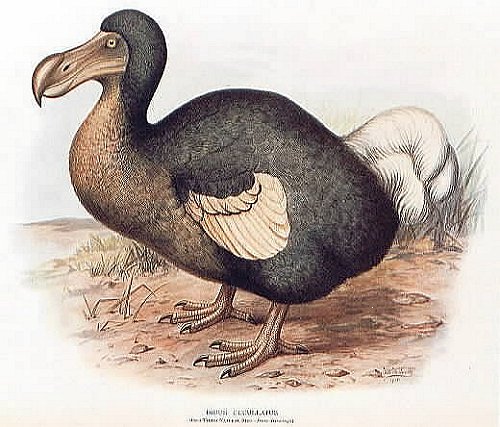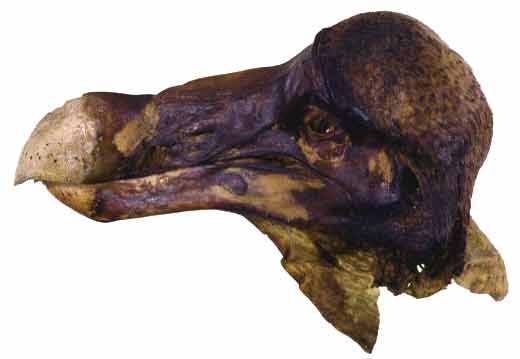
DODO BIRD
Raphus Cucullatus
EXTINCT

Our present day knowledge of what the dodo looked like is based on several sources. There are accounts from the diaries and writings of the sailors and captains who landed on Mauritius in the 16th and17th century, drawings from the few humans who were able to witness them alive (although, it can't even be proven that all the artists who rendered the dodo ever actually saw one) and the few fossils excavated from the island, which are kept at the British Museum, and a foot and a beak which are preserved at Oxford.


Preserved head & foot
From these records and pictures, scientists and ornithologists have pieced together a fairly detailed composite of the dodo. The dodo was a large, plump bird covered in soft, grey feathers, with a plume of white at its tail. It had small wings that were far too weak to ever lift the dodo off the ground. Because it was flightless, those who saw the bird often thought it had no real wings at all, describing them as "little winglets." Study of the skeleton reveals, however, that the dodo did in fact have wings that were simply not used for flight, much like penguins' wings.
The dodo's legs were short and stubby and yellow in color. On the end of the legs were four toes, three in front and one acting as a thumb in back, all with thick, black claws. The head was a lighter grey than the body, with small, yellow eyes. Many words have been devoted to the long, crooked and hooked beak, which was light green or pale yellow in color and was one of the most distinguishing features of the dodo. Those who saw it, marveled at the unique shape and size. One witness went so far as to describe it as grotesque. (Strickland and Melville, 1848) (Fuller, 1987) (Greenway, 1958) (Britannica, 1986)
Scientists thoughts on the diet of the dodo are based mainly on speculation. Some sailors' accounts talk of watching dodos wade into water-pools to catch fish. They have been described as "strong and greedy" hunters. What really fascinated the visitors to Mauritius, however, was the fact that dodos seemed to eat stones and iron frequently and with no trouble. It is now surmised that the rocks eased digestion. (Strickland and Melville, 1848) (Fuller, 1987)
Specifics about mating and incubation periods are not known. Several people have described the nests the dodo made as being deep in the forest, in a bed of grass. There, the female would lay one egg, which she would protect and raise. One sailor told about hearing the cries of a young dodo in its nest, which sounded "like that of a young goose." (Fuller, 1987) (Greenway, 1958)
The sailors who landed on Mauritius found much amusement in watching the clumsy dodo's behavior. There is a story one told of watching a dodo attempt to escape in a hurry. When it tried to run away, (wobble may be a more accurate term), its belly would drag on the ground and slow him down. But for the most part, the dodo is described as a lazy, rather dumb animal. It had virtually no defenses against predators, except for its large beak which could deliver a "fearsome bite" if the occasion arose, such as a threat to itself or its young. (Fuller, 1987) (Strickland and Melville, 1848)
Although many pictures and stories place the dodo along the shores of Mauritius, it was actually a forest-dwelling bird. The island of Mauritius is home to a variety of biomes, such as plains, small mountains, forests, and reefs all along the shores. However, the dodo made its home primarily in the forest. (Fuller, 1987) (Britannica, 1986)
Biomes: tropical deciduous forest, tropical scrub forest, tropical savanna & grasslands, reef
The main purpose dodos served to humans, in the brief contact between the two species, was as food. The sailors frequently fed on wildlife from Mauritius while staying there, although it has been said that dodo meat was not particularly tasty. Still, they were hunted intensely, with sailors sometimes bringing back as many as 50 at a time. What they couldn't eat right away they would salt and bring back with them. A few attempts were made to bring back a dodo alive. When this was successful, entrepreneurs would capitalize on the unique looks of the bird and tour the dodos around Europe, displaying them in cages and demonstrating how the dodo could "eat" stones. (Strickland and Melville, 1848) (Fuller, 1987)
The first group of sailors believed to have arrived on Mauritius were Portuguese, led by Captain Mascaregnas, in 1507. They had intended to land on the Cape of Good Hope in South Africa, but stormy conditions had blown them off course and they ended up finding respite on Mauritius. Several other expeditions, Portuguese, Dutch, British and others, made stops at the island in the following years. In the dodos, the sailors found amusement and, when they were running out of supplies, food. The Dutch colonized Mauritius in 1644 . Along with groups of people, the ships brought cats, dogs, swine and sometimes monkeys. These animals quickly invaded the woods, trampling the nests and frightening the birds. These domestic creatures also devoured the dodo eggs and young. The interference of the foreign animals coupled with the continued overuse of the birds for food led to its total extinction by 1693. (Strickland and Melville, 1848) (Britannica, 1986)
Other Closely Related & Extinct Species